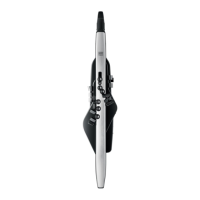26
Scene Parameters
Parameter Value Explanation
Vibrato Depth -64–0–+63
This adjusts the depth of the vibrato eect (the depth at which the pitch is
modulated).
The pitch is modulated more greatly for higher settings, and less with lower
settings.
Vibrato Delay -64–0–+63
Adjusts the time until vibrato (pitch modulation) starts to apply.
Higher settings produce a longer time before vibrato begins, while lower settings
produce a shorter time.
SCENE/EQ
Parameter Value Explanation
EQ Switch OFF, ON
Sets whether to use the part EQ (an equalizer applied to each part) is used (ON) or
not used (OFF).
Input Gain -24–+24 dB Adjusts the amount of boost/cut for the input to the EQ.
Low Gain -24–+24 dB Adjusts the amount of boost/cut of the low frequency range.
Low Freq 20–16000 Hz Sets the center frequency of the low range.
Mid Gain -24–+24 dB Adjusts the amount of boost/cut of the middle frequency range.
Mid Freq 20–16000 Hz Sets the center frequency of the middle range.
Mid Q 0.5–16.0
Sets the bandwidth of the middle frequency range. Higher values make the width
narrower.
High Gain -24–+24 dB Adjusts the boost/cut of the high frequency range.
High Freq 20–16000 Hz Sets the center frequency of the high range.
SCENE/OUTPUT
Parameter Value Explanation
Part Level 0–127 Sets the volume of each part.
Part Pan L64–0–63R Sets the panning of each part’s sound when using stereo output.
Chorus Send 0–127 Species the send level to chorus.
Delay Send 0–127 Species the send level to delay.
Reverb Send 0–127 Species the send level to reverb.
Output Assign DRY, IFX Selects the output destination for each part.
SCENE/CONTROL
Parameter Value Explanation
Mono/Poly MONO, POLY, TONE
Choose “MONO” if you want the tone assigned to the part to play monophonically;
choose “POLY” if you want to play it polyphonically.
Choose “TONE” if you want to use the setting specied by the tone.
Legato Switch OFF, ON, TONE
Legato is enabled when Legato Switch is “ON” and Mono/Poly is set to “MONO.”
Choose “TONE” if you want to use the setting specied by the tone.
This makes the pitch change smoothly while you are playing one note and then
play legato by ngering another key.
Portamento Switch OFF, ON, TONE
Select “ON” to apply portamento, or “OFF” if you don’t want to apply portamento.
Choose “TONE” if you want to use the setting specied by the tone.
Portamento Time 0–127, TONE
When portamento is used, this species the time over which the pitch changes.
A higher value increases the time it takes for one pitch to slide to the next.
Choose “TONE” if you want to use the setting specied by the tone.
Unison Switch OFF, ON, TONE
This layers a single tone.
Choose “ON” if you want to use unison, or “OFF” if you don’t.
Choose “TONE” if you want to use the setting specied by the tone.
* Parts whose Unison Switch is “ON” play in mono.

